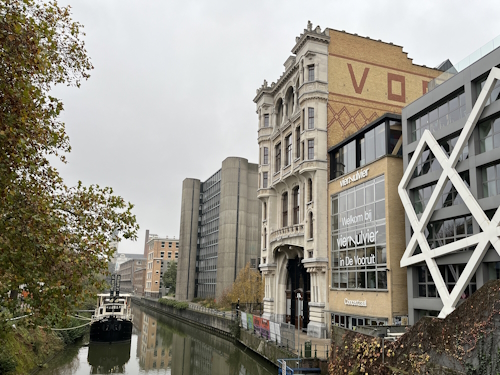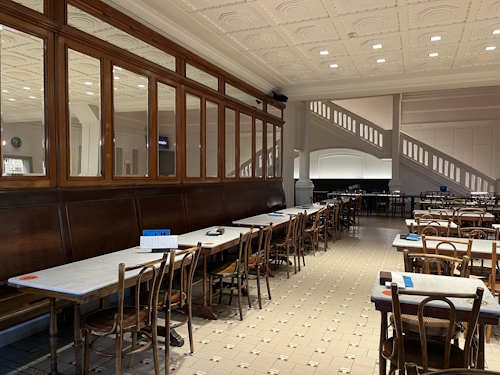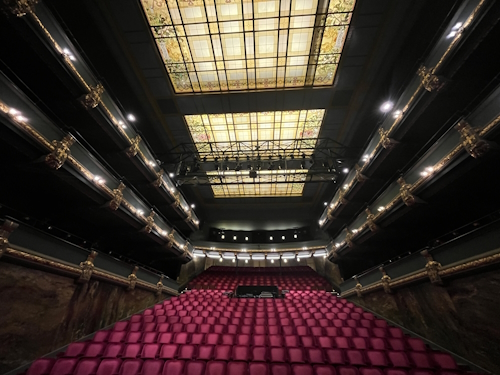Blog TWHS Visits
Workers' Assembly Halls (Belgium)
The Workers' Assembly Halls, a nomination led by Denmark, is one of the more prominent upcoming serial transnational initiatives. It is aiming for inscription in 2027. They represent the international democratic labour movement of the years 1850 to 1950. This isn’t a popular subject in 2024, but “we” (the workers in the countries where the labour movement had a significant impact) owe perks like the 8-hour workday and holiday bonuses to them.
Among the 7 proposed Assembly Halls in 6 countries is “De Vooruit” in Ghent, Belgium. It doesn’t feature on the country’s tentative list yet, but it is definitely part of the final selected group that is preparing a nomination and it has received funding to do so from the Flanders government. I visited it yesterday on a guided tour.
The ‘Vooruit’ (Dutch for “Forward”) dates from 1913, the year Ghent hosted an International Exhibition. It seemed a good idea to the local socialist movement to celebrate its cause via a grand building, which was to be situated along the main road between the railway station and the city centre. The construction was funded by the eponymous socialist cooperative, which managed a bakery, a brewery, pharmacies, and other businesses aimed at the socialist customer. Workers could use its services against fair prices, to protect them from rampant capitalism.
The building has a very fine facade, but unfortunately, it is completely covered in scaffolding at the moment (works to improve its accessibility will last until 2026). The halls on that side are also closed off, except for the cafe - the only part that has been in continuous use for the same purpose since the early days. It even still feels like a workers’ cafeteria, while its leftist and student appeal is reflected in dishes like “dessert for Gaza”.
Our guided visit focused on the back of the building. It has a fine setting along the river Scheldt as well (see photo 1). Here we find the concert hall and the theatre. The concert hall and many of the other rooms we passed through do show slight touches of Art Nouveau, but nowadays its design is mostly utilitarian. The building has to comply with modern health and safety standards and has survived performances by bands like Nirvana and Motörhead. It also needs to be cost-effective: to battle the enormous energy bill, solar panels have been placed on the roof and a modern heating system was installed.
The best part of the tour was at the Theatre. It also has been modernized a lot, but "socialist" details remain such as a banner with the slogan “Art Ennobles” above the stage. Its ceiling has great stained-glass windows, typical Art Nouveau, with the musical notes of the socialist anthem The Internationale incorporated into the design.
Considering the Workers’ Assembly Halls in general, the nomination is carried by a convincing historical narrative (global labour movement of the late 19th and early 20th centuries), but I wonder (1) how authentic its tangible remains are, and (2) what each of the 7 components adds to the story (aren’t the similarities too superficial?). The Vooruit does have the correct roots, but to be honest, it is far from a great sight on the scales of Art Nouveau (no match for the Horta Town Houses) or monumental theatre buildings (I’d rather see the Amazonia Theatres inscribed).
“De Vooruit” at the moment can only be visited with a guided tour in Dutch, which is available about once a month on a Saturday. The rest of the year it is in use for concerts and events, which seems to be the case for Paasitorni (Finland) as well. Several other Assembly Halls have accessibility issues too, which I hope will be overcome when the site is inscribed: the CGT in Buenos Aires is an office for the Labour Union, and the Redhills Durham Miners Hall in the UK is currently closed for renovation. And we eagerly await a review of the Australian components (Broken Hill, Melbourne)!
Els - 10 November 2024
Comments
Els Slots 11 November 2024
I think the only part that is fully accessible in Gent at the moment is the café.
Nan 10 November 2024
Gent has a public section. As does the site in Helsinki. I would argue all of the building serves as a workers hall.
Els Slots 10 November 2024
Which site do you mean, Nan?
Nan 10 November 2024
Small correction: You can enter, but you won't see the big hall. I assume the complete building will be inscribed, not just the singular hall.
Els Slots 10 November 2024
It has a very interesting history, the one in Winnipeg. As I said, a big hurdle for the nomination is to make clear in the comparative analysis why some sites were chosen and others weren't.
Els Slots 10 November 2024
It doesn't seem that to have made the cut, according to the latest reports which all talk about the mentioned 7.
Kyle Magnuson 10 November 2024
So will the Worker's Assembly Hall (Ukrainian Labour Temple) in Winnipeg, Canada not be included?


